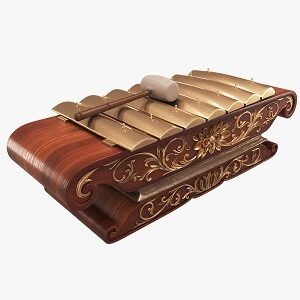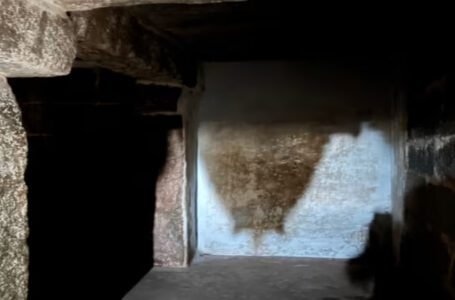The Music of Metal: Exploring the World of Metallophones

INTRODUCTION
A metallophone is a musical instrument that belongs to the percussion family and produces sound by striking metal bars with a mallet. It is similar to a xylophone and often used in orchestras, bands, and ensembles to create a bright, ringing tone. Metallophones typically have a resonator box underneath the metal bars to amplify their sound and come in various sizes and ranges. Metallophones have been a popular choice for musicians for centuries with their versatility and distinctive sound.

ORIGIN OF THE METALLOPHONE
The origin of metallophones can be traced back to Southeast Asia, where they have been used in traditional gamelan music for hundreds of years. The exact origins are unclear, but the instrument is thought to have been influenced by other similar instruments from the region, such as xylophones and vibraphones. Over time, metallophones spread to other parts of the world and were adopted into Western classical music, where they have become a staple of orchestras and percussion sections. Today, metallophones can be found in various musical styles and settings, from classical to jazz to pop.
The history of metallophones dates back several centuries to Southeast Asia, where the instrument was a key component of traditional gamelan music. It is believed that metallophones were influenced by other similar instruments in the region, such as xylophones and vibraphones. Over time, the instrument spread to other parts of the world, and by the 19th century, metallophones had made their way into Western classical music.

In the 20th century, the metallophone continued to evolve and gain popularity in various musical styles, from classical to jazz to pop. The instrument was used in orchestras, bands, and ensembles, and manufacturers began producing a variety of different models, each with its own unique sound and range. Today, the metallophone remains a popular choice for musicians around the world, and its bright, ringing tone continues to be a staple of percussion sections in many different types of musical performances.
HOW METALLOPHONES ARE MADE
A metallophone is typically made up of several metal bars, each of which produces a specific pitch when struck with a mallet. The metal bars are mounted on a resonator box, which amplifies the sound and provides the instrument with its characteristic bright, ringing tone.

The metal bars themselves are made from a variety of materials, including steel, aluminium, and bronze, and are typically tuned to precise pitch to ensure accurate musical performance. The resonator box is typically made of wood or metal and contains several resonating chambers that amplify the sound of the metal bars when they are struck.
The mallets used to play the metallophone are typically made from a soft material, such as rubber or felt, to produce a bright and resonant tone. Different types of mallets can be used to produce different tones and volumes, allowing the player to create a wide range of musical expressions on the instrument.
Overall, the process of making a metallophone involves carefully crafting and tuning each metal bar and resonator box, as well as selecting the right materials and construction techniques to ensure the highest quality sound and performance.

SEVERAL TYPES OF METALLOPHONES
There are several different types of metallophones, each with its own unique features and sound. Some of the most common types of metallophones include:
- Orchestra metallophones – This type of metallophone is designed for use in orchestras and other classical music settings. It is typically larger than other types of metallophones and has a wide range of pitches.
- Javanese metallophones – This type of metallophone is used in traditional Javanese gamelan music and has a distinctive, bright sound that is well-suited to this style of music.

- Solo metallophones – This type of metallophone is designed for solo performance and typically has a smaller range of pitches than other types of metallophones.
- Bass metallophones – This type of metallophone is designed to play the lower pitches in musical performance and often has a deeper, more resonant sound than other types of metallophones.
- Marimba-style metallophones – This type of metallophone is similar in design to a marimba, with long metal bars and a more complex resonator system. It is often used in jazz and other contemporary music styles.
Overall, the type of metallophone you choose will depend on your musical style, the type of music you play, and your personal preferences.
FEATURES OF METALLOPHONES
The features of a metallophone can vary depending on the type of instrument and its intended use. However, some common features of metallophones include:
- Metal Bars – The metal bars of a metallophone are what produce the sound when struck with a mallet. They are typically made of steel, aluminium, or bronze, and are carefully tuned to precise pitches.

- Resonator Box – The resonator box of a metallophone amplifies the sound of the metal bars and gives the instrument its characteristic bright, ringing tone. It is typically made of wood or metal and contains several resonating chambers.
- Mallets – The mallets used to play the metallophone are typically made of rubber or felt and are designed to produce a bright, resonant tone. Different types of mallets can be used to produce different sounds and volumes.
- Range – The range of a metallophone refers to the number of pitches it can produce and the span of pitches it can cover. Some metallophones have a wide range of pitches, while others are designed for specific pitch ranges.
- Durability – Metallophones are typically built to last, with high-quality materials and construction techniques that ensure the instrument will hold up to regular use.
- Portability – Some metallophones are designed to be portable, with lightweight construction and the ability to be easily disassembled and reassembled.
- Tone Quality – The tone quality of a metallophone is a key feature, with different types of metallophones producing different sounds and resonances.
- Versatility – Metallophones are versatile instruments that can be used in a wide range of musical styles, from classical to jazz to pop, and are suitable for both solo and ensemble performances.
Overall, metallophones are versatile instruments that offer a bright, ringing tone and a wide range of musical expressions. Whether you’re playing in an orchestra or a jazz ensemble, a metallophone can provide the perfect complement to your musical performance.
LIST OF FAMOUS MUSICIANS OF METALLOPHONES
As the metallophone is not commonly played as a solo instrument, there are not many famous musicians who specialize in playing it. It is typically used as part of an ensemble or as a supporting instrument in various styles of music, including classical, world music, and contemporary styles such as jazz.
However, some musicians who are well-known for their work with the metallophone include:
- Evelyn Glennie – A Scottish percussionist and composer who has used the metallophone in many of her performances and recordings.
- Colin Currie – British percussionist and educator who has performed as a soloist and collaborated with many of the world’s leading orchestras and ensembles.
- Aiyun Huang – Chinese-Canadian percussionist and educator who has performed and recorded with a variety of ensembles and orchestras.

These musicians have demonstrated the versatility and musical potential of the metallophone through their performances and recordings, and continue to inspire new generations of musicians and audiences alike.
CURRENT SCENARIO
The current scenario for metallophones is that they continue to be used in a variety of musical styles and settings, including classical orchestras, world music ensembles, and contemporary music groups. They are also used in many educational settings, as they provide a versatile and accessible introduction to the world of percussion instruments.
In recent years, there has been a growing interest in traditional world music and the instruments used in these musical styles, which has led to an increased demand for metallophones and other percussion instruments. Additionally, the rise of technology and the availability of digital instruments have made it easier for musicians to access a wide range of musical instruments, including the metallophone.
Overall, the metallophone remains an important and versatile musical instrument that continues to be used and enjoyed by musicians and audiences around the world.

CONCLUSION
In conclusion, the metallophone is a unique and versatile musical instrument that has been used for centuries in a variety of musical styles and settings. With its bright, ringing tone and wide range of musical expression, it continues to be a popular choice for musicians and audiences alike. Whether you are a seasoned performer, a music educator, or simply a lover of music, the metallophone is an instrument that offers endless musical possibilities.
In the modern era, the metallophone continues to evolve and adapt to the changing musical landscape, with advances in technology and the increasing popularity of traditional world music and other musical styles. With its enduring appeal and timeless musical qualities, the metallophone is an instrument that is sure to remain a vital part of the musical landscape for generations to come.


